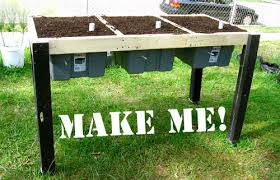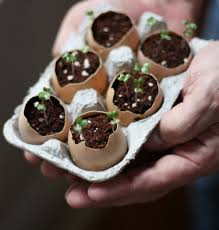No space to grow veg - then try containers
If you think you don't have enough space to grow your own fruit and vegetables, why not try growing your favourites in containers?
Even those of us with just a patio, balcony or small garden can incorporate a pot or two dedicated to tasty edibles. Or they can become an attractive addition to larger gardens, especially if you position them close to your kitchen door to grab a handful of herbs.
 From carrots, peppers, potatoes, onions, to strawberries, blueberries and even apple trees, these are just a few of the flavoursome and nutritious crops that you can grow in containers at home. But why bother?
From carrots, peppers, potatoes, onions, to strawberries, blueberries and even apple trees, these are just a few of the flavoursome and nutritious crops that you can grow in containers at home. But why bother?
There are many reasons why it is an advantage to grow crops in containers:
- ground is not needed, which is great for those with no garden.
- you can control soil texture, composition and nutrients, for example you can use ericaceous compost (pH less than 7.0 for lime-hating plants such as blueberries).
- tender plants can be brought inside for protection during the winter, such as figs and citrus.
- containers can be sited in position s that are easy to access, so people with mobility problems can still garden.
- it is easier to control pest damage to plants in containers rather than in a garden, although some pests like vine weevil can be a problem in containers unless detected and treated early.
- trailing plants can be displayed effectively.
- plants can be forced under cover to give early crops, eg strawberries, salad crops.

You can use anything you like as a container for growing fruit and vegetables, and there are many types available. If you're planting a single specimen, choose a container that is just large enough to hold the roots without them being crushed. Salads and herbs thrive in relatively shallow containers.
A depth of as little as 30cm/8" depth can give good results. More demanding plants, such as legumes, onion family and of course root vegetables do better if you can provide a soil depth of 18" or more, and will avoid you having to water and feed so frequently.
Types of containers:
- multipurpose free-standing, eg pot, trough, tub
- specific free-standing, eg strawberry or herb pot
- window box
- hanging basket
- wall mounte
- tower
- growing bag
- converted, eg chimney pot, sink, barrel, tea pot, old boot
- raised bed
- plastic tubs, with several holes drilled into the base
 |
| http://www.insideurbangreen.org/container-gardening/ |
Types of materials:
- clay/terracotta
- wood
- plastic
- fibre
- stone, reconstituted stone
- concrete
- fibreglass
- glazed earthenware
Whatever type of container you choose, make sure there are adequate drainage holes in the base. Has the material for the container come from an environmentally sound source?
 Although there are many different materials available, bear in mind that terracotta or clay will tend to dry out more easily than plastic alternatives. Think about how often you may wish to move the container, as some containers will be heavier than others of a similar size made out of a different material.
Although there are many different materials available, bear in mind that terracotta or clay will tend to dry out more easily than plastic alternatives. Think about how often you may wish to move the container, as some containers will be heavier than others of a similar size made out of a different material.
Creating a show: Some fruit and vegetables are more decorative than others: lettuce (especially ones of different colours), tomatoes, runner beans, carrots, chard and beetroot, aubergine, cucumber, pepper and some salads. And even potatoes are brilliant grown in dustbins with drainage holes.
In larger tubs try courgettes, French beans, both climbing and dwarf, tomatoes and potatoes.
For smaller pots, consider salads such as endive, lettuce, radish, rocket and spring onions. Spinach, beetroot and its relatives such as chard, and Chinese greens are good choices too. Difficult crops include runner beans and long root cultivars of root crops. Use deep containers, soil-based composts and provide ample water for the beans.
Aim to have two or more crops a year from your tubs. Mange-tout peas can be sown in March and gathered in June, followed by a late crop of French beans or courgettes sown in early July, for example.
 Most herbs can be grown in pots in a free-draining compost. Strawberry pots full of herbs are attractive. Try herbs such as chives, thyme, coriander and parsley. Mint does better in larger tubs.
Most herbs can be grown in pots in a free-draining compost. Strawberry pots full of herbs are attractive. Try herbs such as chives, thyme, coriander and parsley. Mint does better in larger tubs.
Fruit: whatever the container, good drainage is essential, as are watering and feeding weekly with a general liquid feed.
For permanent fruit such as apples or pears, use large containers, about 18" in diameter, and soil-based compost. Pots of this size are difficult to move around. Trees and bushes in their final container should be top dressed annually and re-soiled every other year.
For annuals, or plants that are treated as such, like strawberries, growing bags can be used, or troughs with a soil-less compost.
Staking: put two stakes down the inside edge of the container before planting. These should protrude abut 8" above the container surface. Attach a crossbar and tie into this. This should prevent any movement of the rootball.
 Blueberries and cranberries require ericaceous (lime-free) compost, and are best watered with rainwater.
Blueberries and cranberries require ericaceous (lime-free) compost, and are best watered with rainwater.
Hanging baskets can be used for strawberries and cranberries.
General care:
- mulch the soil surface with a layer of about an inch of gravel to help conserve moisture.
- in hot summers protect containers with wet sacking to reduce the frequency of drying out
- for permanent plantings, protect containers with bubble wrap in winter (or bring under cover) so they do not freeze
- maintain an even water supply and ensure good drainage to prevent waterlogging
- apply a high nitrogen liquid fertilizer if growth flags, and high potassium liquid fertilizer when crops come into flower
- finally, harvest, then sit back and enjoy your produce
From a leaflet produced by the RHS (rhs.org.uk)